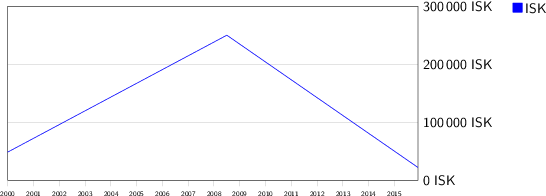|
Ich war doch zu optimistisch, dass ich nun mit Die Beschriftung auf der Y-Achse hab ich versucht in eine Währung zu ändern. Sie sollte in 50 000 Schritten bis zu 300 000 Kronen gehen. Der höchste Datenwert liegt bei 250 000 Kronen. Es gelingt mir nicht die Legende anzupassen. Wie sich das mit \documentclass[tikz]{standalone} \usepackage{pgfplots,filecontents} \pgfplotsset{compat=newest} \usepgfplotslibrary{dateplot} \begin{filecontents}{infla.csv} Year,Interbank 2000-01-01,48550 2008-07-01,250100 2015-12-01,22000 \end{filecontents} \begin{document} \sffamily \begin{tikzpicture} \sffamily \begin{axis}[ date ZERO=2000-01-01, date coordinates in=x, no marks, width=12cm,height=6cm, enlargelimits=false, xticklabel={\tiny\year}, xtick={2000-1-1,2001-01-01,2002-01-01,2003-01-01,2004-01-01,2005-01-01,2006-01-01,2007-01-01,2008-01-01,2009-01-01,2010-01-01,2011-01-01,2012-01-01,2013-01-01,2014-01-01,2015-01-01}, xtick pos=left, xtick align=outside, ymin=0,ymax=300 000, yticklabel={\pgfmathprintnumber[verbatim]{\tick}ISK}, ytick style={draw=none}, yticklabel pos=right, ymajorgrids=true, legend style={ draw=none, legend cell align=left, at={(1.12,1.05)}, anchor=north west, legend image code/.code={ \filldraw[##1] (-.5ex,-.5ex) rectangle (1ex,1ex); } } ] \addplot table[col sep=comma,x=Year, y={Interbank}] {infla.csv}; \addlegendentry{ISK}; \end{axis} \ end{tikzpicture} \end{document} |
|
Standardmäßig skaliert
Hier das vollständige Beispiel (die Legende musste etwas nach rechts rücken, um die y-Achse nicht zu verdecken) \documentclass[tikz]{standalone} \usepackage{pgfplots,filecontents} \pgfplotsset{compat=newest} \usepgfplotslibrary{dateplot} \begin{filecontents}{infla.csv} Year,Interbank 2000-01-01,48550 2008-07-01,250100 2015-12-01,22000 \end{filecontents} \begin{document} \sffamily \begin{tikzpicture} \sffamily \begin{axis}[ date ZERO=2000-01-01, date coordinates in=x, no marks, width=12cm,height=6cm, enlargelimits=false, xticklabel={\tiny\year}, xtick={2000-1-1,2001-01-01,2002-01-01,2003-01-01,2004-01-01,2005-01-01,2006-01-01,2007-01-01,2008-01-01,2009-01-01,2010-01-01,2011-01-01,2012-01-01,2013-01-01,2014-01-01,2015-01-01}, xtick pos=left, xtick align=outside, ymin=0,ymax=300 000, % assume math mode: nicht überprüfen ob der Mathemodus an ist % int detect: keine Nachkommastellen für ganze Zahlen anzeigen % 1000 sep={\,}: Kleiner Abstand zwischen 3er-Kolonnen yticklabel={\pgfmathprintnumber[assume math mode,int detect,1000 sep={\,}]{\tick} ISK}, % y-Achse nicht skalieren, sondern die tatsächliche Zahl im \tick angeben scaled y ticks=false, ytick style={draw=none}, yticklabel pos=right, ymajorgrids=true, legend style={ draw=none, legend cell align=left, at={(1.22,1.05)}, anchor=north west, legend image code/.code={ \filldraw[##1] (-.5ex,-.5ex) rectangle (1ex,1ex); } } ] \addplot table[col sep=comma,x=Year, y={Interbank}] {infla.csv}; \addlegendentry{ISK}; \end{axis} \end{tikzpicture} \end{document} |

